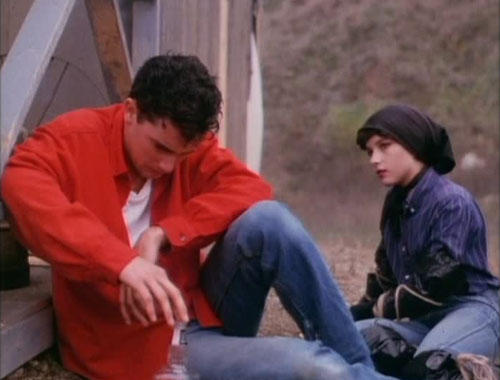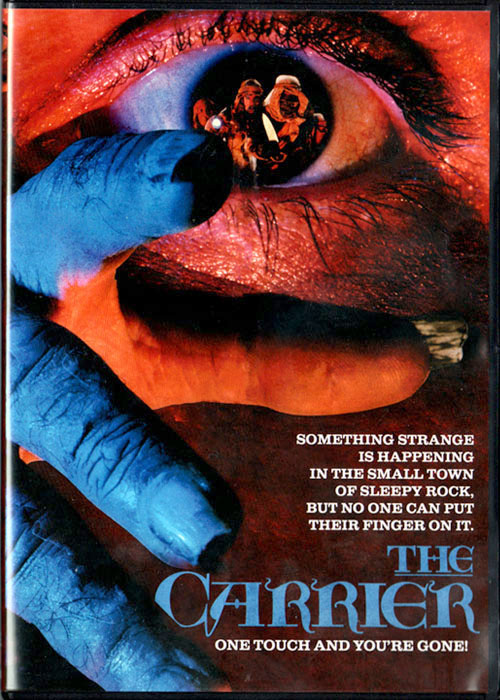The story takes place in the idyllic and isolated little town of SleepyRock, where a young loner named Jake (Gregory Fortescue) lives in a shack on the outskirts of town and is not well liked by most of the townsfolk. It seems that they all believe that Jake's responsible for the house fire that killed his own parents, some years ago. One stormy night, after returning back to his hovel, Jake is attacked by a huge hairy beast, something that the locals casually refer to as "The Black Thing." It's in this split second that the movie suddenly becomes a "monster attacks" story, as Jake is lightly mauled and clawed across his chest, but just as quickly as it all happens, Jake shoots the creature and it melts into a puddle of goo outside his home.
Even stranger than all that is the disease that the monster infects Jake with. It seems that Jake's touch has become lethal to any living thing, and to make matters worse, anything he touches becomes infected and deadly to the touch. We discover this in the most amazing/absurd way. Jake gives this old man a stack of books, throwing them into a bag. Later when the old man goes to look at them, he picks up a copy of One Fish, Two Fish, Red Fish, Blue Fish, and it melts to his hand before it starts dissolving the rest of his arm! He runs out into the street, screaming, and some local guys cut his arm off with a hatchet to save his life.
Of course, the town goes berserk, almost into an immediate panic. It doesn't help that the storm has knocked the bridge out, isolating the community. The local doctor, Anthony King (Steve Dixon), starts testing the infectious material. First he puts a baby chick on the book. It melts. So he starts rubbing baby chicks on things in town, like mailboxes, doors, telephone poles, and marking anything that melts a baby chick with the color red.
The doctor also instructs everyone in town to not make direct contact with one another and to cover themselves as best as possible, with coats, gloves, blankets, and especially plastic. In fact, he recommends that they all put plastic over their heads, something that I think might be rare for a doctor to do.
Some townspeople don't heed the warning too well; one guy is melted while sitting down in an outhouse, which is kinda funny. Not so funny is when a girl is raped by her boyfriend in the woods, but she touches an infected tree during the assault, killing herself and her attacker. It's pretty shocking, and later some people find their pile of smoking clothes and one guy says, "stupid kids," which I think might be a comment on attitudes at the time towards date rape. Possibly. Maybe...?
The town eventually splits into two factions, one a religious group called the Joneses and the other, the Barmen, who are more like biker trash. The Joneses wear mostly cloths and clear plastics, while the Barmen wear black trash-bags and leather. You can at least tell the groups apart, but individuals within the groups are obscured by bags and masks over their heads. The Joneses set up an encampment within their farmhouse, while the Barmen set up in an old barn.
The movie then turns into a little post-apocalyptic/survivalist battle between these two groups over the control of cats. Yeah, that's right. . .cats. There seems to an overabundance of strays in the area, and the two groups have run out of baby chicks, so logically they decide that cats are what they need to try to stay safe and protected. They all go out and hunt cats, trapping them in boxes and whatnot, but these kitties have become hot commodities, and the two groups come to blows over them, even shedding blood.
Where does our gimpy hero Jake fit into all this? Well he overhears some of the Barmen talking about how some of the townspeople are actually responsible for his parents death, and how they convinced Jake that he did it. So Jake convinces the Barmen to attack the Joneses for their own protection, while he also warns the Joneses that an attack is coming (shades of Yojimbo). In a scene that is played completely serious, the Barmen gather outside the fence surrounding the Joneses' compound, weapons in their hands (many of them infected objects), and the leader of the Barmen demands that they give up all of their cats, saying that they choose between "Cats or death?!!" It's ridiculous, but played completely straight faced, a pattern the entire movie follows.
Following an epic battle, with lots of casualties, the townspeople show cooler heads and meet to discuss what to do next. Doctor King wants to sneak Jake out of the town (he doesn't want them to kill Jake, but I'm not sure why he wants to send this mysterious disease and it's carrier out into the world at large) so he lies to everybody and announces that the carrier was killed in the battle and that everyone is safe. Of course, this doesn't go quite as planned, as Jake's secret is discovered by one of the youngest townspeople, and he must try to make his escape with the enraged citizens right behind him. Will he escape? Will the town be destroyed? How will it all end? Will Jake turn into another "Black Thing?" (I can answer that last one: no).
 |
| "Touch the wall, Jake!" |
The film is a period piece, apparently, as the movie is bookended by some flimsy narration, which states this story took place "25 years ago," which in relation to '88 means that this story takes place in 1963. There's not much that makes it specific to the period (except maybe Jake's James-Dean-Rebel without-a-Cause shirt), but there's also nothing that really gives it away as being the 1980s. So, good job, I guess?
The special effects vary in quality, like "The Black Thing," which is just a guy in a weird gorilla suit, but a few sequences do shine, specifically the initial attack by the deadly Dr. Seuss book, and another when a woman is killed by her full length mirror, the shards of glass melting into her skin. Also, some guy gets an infected bible to the face, which was cool. There's a few melty looking bodies in the film, but generally when people die from infected objects there's just a bunch of smoke and they die off-screen, leaving behind a puddle of clothes.
 |
| Our sulking hero, Jake |
Along with its absurdities and general oddness, there's a conflicting and definite mean streak running through the film, as featured in the sexual assault scene, as well as with the deaths of multiple children, baby chicks, and cats. It's all done with such non-chalantness that it seems that the filmmakers didn't know that these things were taboo. It's either really ballsy or it shows a certain naivety.
Despite it's low-budget shoddiness, the film and the filmmakers where obviously trying to imbue their film with some subtext. There's lots of religious symbolism going on between the warring groups of townsfolk and during the climatic ending. The disease itself seems to be an allegory for AIDS and the fear that spread in the late 80s surrounding the way the disease is communicable and what it means for those that are carriers of the disease. It's not the most subtle of subtexts, but it's definitely present.
The Carrier shares some film-crew-connections to the films of Sam Raimi, a fellow native of Michigan. The matte painter (Bob Kayganich), stop motion animator (Larry Larson), and post-production sound guy (Ron Ayers) all worked on Evil Dead II (1987), but the most significant behind the scenes credits would belong to composer Joseph LoDuca and cinematographer Peter Deming.
Joseph LoDuca would compose the scores for Raimi's The Evil Dead (1981), Evil Dead II, and Army of Darkness (1992), and would continue working on Raimi-produced television shows, such as Hercules: The Legendary Journeys, Xena: Warrior Princess, Young Hercules (with a young Ryan Gosling), and Cleopatra 2525. In addition, he has also worked on more recent TV hits like Leverage and Spartacus: Gods of the Arena and War of the Damned.
Cinematographer Peter Deming has the most impressive filmography of anybody that worked on The Carrier. He would cut his teeth shooting horror films like Evil Dead II, The Carrier, and Scarecrows (1988), before heading into an extremely varied career. He would work on comedies (House Party [1990], Drop Dead Fred [1991], Son in Law [1993], Austin Powers [1997], Goldmember [2002]), with Oscar winners (My Cousin Vinny [1992], I heart Huckabees [2004], The Jacket [2005]), David Lynch (Lost Highway [1997] and Mulholland Dr. [2001]), Wes Craven (Scream 2, 3, and 4 [1997/2000/2011], Music of the Heart [1999]), and one of the better domestic horror films of recent times, The Cabin in the Woods (2011). Peter Deming would re-team with Sam Raimi on his return to the horror genre, Drag Me to Hell (2009), as well as on Raimi's most recent film (which, coincidentally, opens this weekend), Disney's OZ: The Great and Powerful.




No comments:
Post a Comment